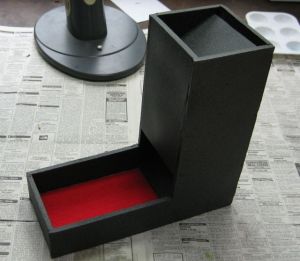 No item in boardgaming is as shrouded in mystery and superstition as our dice. As Russ noted in an earlier post, part of the fun of gaming with a wide variety of people is seeing the various ways in which they use their dice–towers, cups, blown kisses, and good-luck jigs. We praise and thank them when they shower good fortune on us, according “lucky dice” positions of honor in our dice bags. We also hurl so-called “bad dice” across the room where they roll under the water heater, never to be seen again, or punish them with a few seconds of radiation in the microwave (true story, by the way–I know a guy who knew a guy…)
No item in boardgaming is as shrouded in mystery and superstition as our dice. As Russ noted in an earlier post, part of the fun of gaming with a wide variety of people is seeing the various ways in which they use their dice–towers, cups, blown kisses, and good-luck jigs. We praise and thank them when they shower good fortune on us, according “lucky dice” positions of honor in our dice bags. We also hurl so-called “bad dice” across the room where they roll under the water heater, never to be seen again, or punish them with a few seconds of radiation in the microwave (true story, by the way–I know a guy who knew a guy…)
You’d think the boardgame manufacturers would understand. But no. In an effort to cut costs, they package their games with “weak bones.” The results speak for themselves: cheap cubes which roll on our tables like drunken fratboys down the streets of New Orleans at Mardi Gras. There are two major types of offenders:
Woodies: Found primarily in Euro style games like Settlers of Catan and Small World. I swear these are made out of balsa wood. They weigh almost nothing and become quite dangerous in the hands of vigorous dice shakers. It’s not uncommon to see them bounce ten feet after hitting the tabletop, and they eventually end up in the cat’s mouth, under the china cabinet, or out the open window and into the neighbor’s yard. Pros: Will float. Cons: Energy properties of Flubber.
Chaddies: Found in all sorts of games, World at War: Blood and Bridges being the worst offender in my collection. These are cheap plastic cubes with hanging bits of waste material or irregular corners, usually as a result of a bad casting process. These dice wobble around like a carnival Tilt-a-Whirl ride, coming to rest at an angle that can only be described as “cosmically wrong.” Pros: Might look right if you’re playing while sampling “mood enhancers.” Cons: Can’t be trusted to “roll true.”
How either of these types of dice make it through quality control into our boardgames is beyond me. Any gamer worthy of the title will remove them immediately from his games. In my own case, this has led to the dreaded “reject box,” full of neglected woodies and chaddies. To replace them, I have purchased dice from Chessex. But the whole situation begs the question: why are manufacturers putting these terrible dice in our games? I have heard that it is quite expensive to get dice made for a game, and those costs are passed along to the consumer. Why not just ship games with a) quality dice (and most of us will happily pay the extra cost), or b) ship the games without any dice (thereby making the games cheaper), leaving us to make our own decisions? The half measure–terribly made dice–is just frustrating.



 Posted by John
Posted by John 
